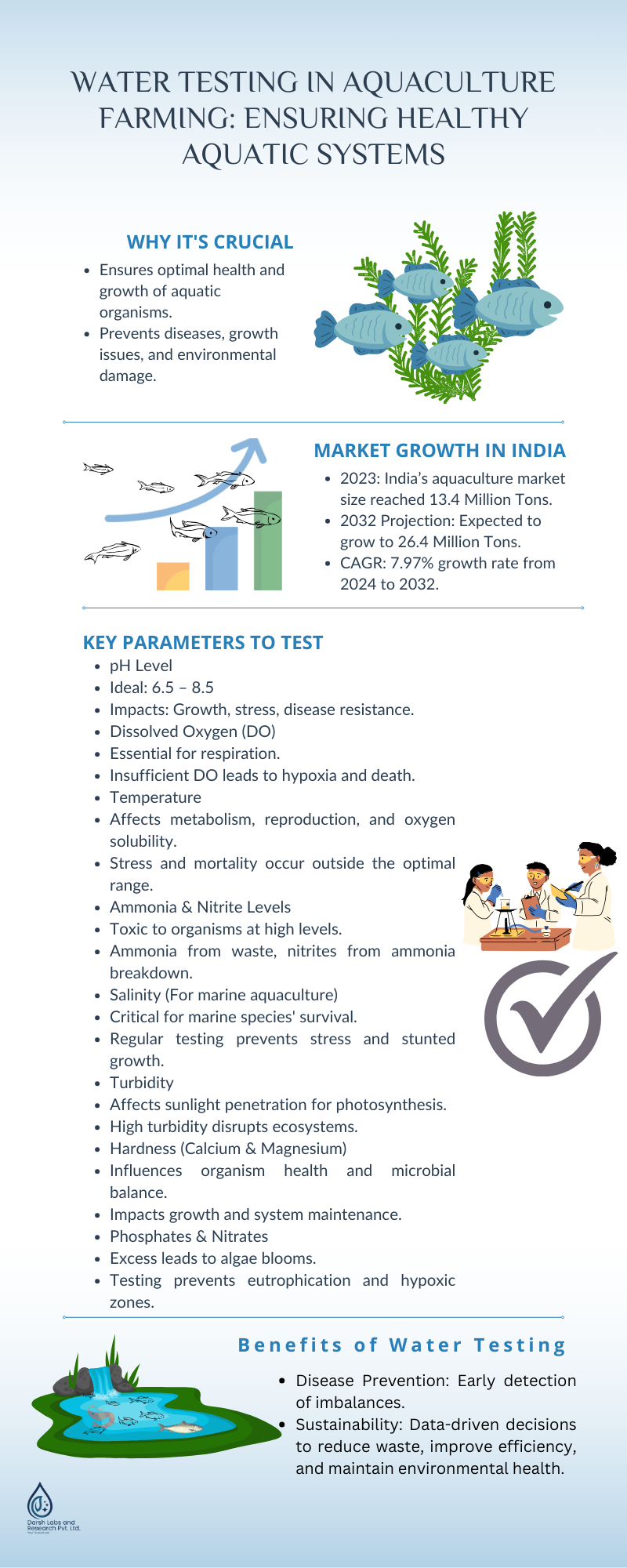In the rapidly growing world of aquaculture farming, ensuring the health of aquatic organisms is paramount. One of the most critical components in managing a successful aquaculture system is water testing. Aquatic environments are highly sensitive to changes in water quality, which can directly impact the growth, reproduction, and overall well-being of farmed species. Thus, regular and thorough water testing is necessary to maintain the health of both the organisms and the environment in which they live.
Water quality in aquaculture systems is influenced by a variety of factors, such as physical, chemical, and biological parameters. Monitoring these factors through water testing can help farm managers prevent issues before they escalate, ensuring a productive and sustainable farming operation. Let us explore why water testing is essential, the different parameters involved, and how it helps in maintaining optimal conditions for aquaculture systems.
The Importance of Water Testing in Aquaculture
Aquaculture farming involves raising fish, shellfish, or other aquatic organisms in controlled environments such as tanks and ponds. Unlike wild aquatic ecosystems, where water quality fluctuates naturally, aquaculture systems require more precise management to ensure optimal conditions for growth and health.
Regular water testing helps to identify and mitigate potential risks associated with water quality. Poor water quality can lead to a host of problems, including poor growth rates, disease outbreaks, stress among farmed organisms, and even massive die-offs. By implementing consistent water testing, farmers can adjust and optimize conditions such as oxygen levels, pH, and salinity, which can significantly enhance the productivity of their aquaculture systems.
Key Parameters in Water Testing
There are several critical parameters that must be monitored through water testing to ensure that the water is suitable for the farmed species.
The following are the key aspects of water testing in aquaculture farming:
- pH Level
The pH value shows how sour or soapy the water is. Aquatic organisms are sensitive to changes in pH, and extreme values (either too high or too low) can cause stress, reduce growth rates, and increase susceptibility to diseases. Regular water testing for pH helps farmers maintain a balance within the optimal range, typically between 6.5 and 8.5, depending on the species.
- Dissolved Oxygen (DO)
Oxygen is essential for the breathing processes of organisms living in water. The concentration of dissolved oxygen in water is influenced by temperature, salinity, and biological activity. Insufficient oxygen levels, which can occur due to overcrowding, excessive feed, or inadequate water movement, can lead to hypoxia (low oxygen levels) and death. Water testing for DO is essential to prevent such conditions and ensure that farmed organisms receive adequate oxygen for healthy growth.
- Temperature
Temperature plays a critical role in the metabolic rates of aquatic organisms. It affects oxygen solubility, growth, reproduction, and disease resistance. Regular water testing for temperature ensures that conditions remain within the ideal range for the specific species being farmed. Temperature fluctuations outside this range can cause stress or even mortality in some species.
- Ammonia and Nitrite Levels
Ammonia and nitrites are nitrogen compounds that can accumulate in aquaculture systems, especially in intensive farming environments. Ammonia, which is toxic even at low concentrations, is primarily produced by fish waste, uneaten food, and organic matter. Water testing for ammonia levels is essential to prevent toxicity. Nitrite, another harmful byproduct, is produced during the biological breakdown of ammonia. Monitoring both ammonia and nitrite levels through regular water testing ensures that their concentrations remain at safe levels.
- Salinity
For marine aquaculture, salinity is a critical parameter. Species such as shrimp, mollusks, and marine fish are adapted to specific salinity levels. Regular water testing is required to ensure that the salinity levels are optimal for the species being farmed. Salinity variations outside the preferred range can cause stress and hinder growth.
- Turbidity
Turbidity describes the murkiness or opaqueness of water due to particles suspended within it. High turbidity can block sunlight, reducing photosynthesis in aquatic plants and disrupting the overall ecosystem. Water testing for turbidity is essential to maintain clear water, allowing for the proper growth of algae and other organisms in the system.
- Hardness (Calcium and Magnesium)
Water hardness, primarily influenced by the concentration of calcium and magnesium ions, impacts the health of both the farmed species and the microbial environment. Low hardness can lead to issues such as poor fish growth, while excessively hard water can result in scale formation in tanks and pipes. Regular water testing for hardness helps farmers maintain an ideal environment for aquaculture.
- Phosphates and Nitrates
Phosphates and nitrates are nutrients that, when present in excess, can promote the growth of algae and lead to eutrophication, a condition where oxygen is depleted in the water. This can result in hypoxic zones where fish and other organisms cannot survive. Water testing for phosphates and nitrates is crucial to prevent algal blooms and maintain water quality.

The Role of Water Testing in Preventing Disease Outbreaks
In aquaculture farming, disease management is a critical concern. Poor water quality often serves as a breeding ground for pathogens that can lead to disease outbreaks. Regular water testing allows farmers to detect early signs of imbalances that may make their systems more vulnerable to diseases. By adjusting parameters such as temperature, oxygen levels, and ammonia concentrations, farmers can mitigate the risks of disease before they spread through the population.
How Water Testing Enhances Sustainable Aquaculture
Sustainability is a key goal for modern aquaculture operations. Over time, poor water quality can lead to environmental degradation and reduced productivity. By conducting regular water testing, farmers can make data-driven decisions to optimize water use, reduce waste, and improve the overall efficiency of their operations. This not only ensures better growth and health for the farmed organisms but also minimizes the environmental impact, contributing to a more sustainable aquaculture industry.
Water quality is the foundation of a healthy and productive aquaculture system. Through regular and thorough water testing, farmers can maintain optimal conditions for their farmed species, prevent disease outbreaks, and contribute to the long-term sustainability of the industry. By monitoring parameters such as pH, dissolved oxygen, ammonia, and salinity, aquaculture farmers can make informed decisions to improve the health of their aquatic systems. Therefore, water testing is not just a routine task; it is an essential practice that ensures the success and sustainability of aquaculture farming. With careful attention to water testing and management, aquaculture operations can continue to thrive while protecting the environment and supporting food security.


Leave a Reply